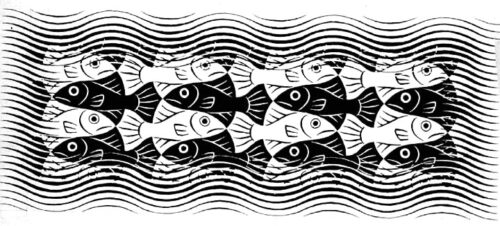The more work I do on post quantum encryption, the more deja vu I feel. At first it was mysterious and sophisticated, yet after a few years the magic is gone.
Here’s what I have been thinking about lately: You can’t have a thing without a not-thing. You can’t have change without something staying the same. You can’t have sameness without something against which it’s same. Light means shadows.
That seems like a children’s book.
Yet the most advanced physicists have built elaborate mathematics to describe a universe that a simple Escher symbol of interlocking fish already captures: existence is mutual arising.

The parts don’t precede the whole. The whole doesn’t precede the parts. They co-emerge.
Imagine handing someone a one-sided coin. Impossible. Yet that’s what we call “classic” and the two-sided coin of normal everyday life gets called “weird” and “strange”. The coin-ness, the thing that makes it function as a coin, requires both sides existing simultaneously. The duality isn’t a property the coin has, it’s not strange, it’s what we think a coin IS.
But it gets even worse. Physicists want us to be surprised that flipping a coin or spinning it—let alone flipping a spinning coin—has been “found” possible.
Quantum mechanics keeps “discovering” that systems naturally have duality, and each time it’s treated as strange. But the strangeness is in the assumption that a oneness was ever our default. A particle with definite position and no momentum isn’t a particle. An electron with spin-up and no relationship to spin-down isn’t an electron. These things exist AS dualities, not as single-sided entities that happen to have another side.
The impressive sounding Tsirelson bound is a perfect example of the error. Rotate a coin, and the bound treats rotation as one thing. But why would an operation on a two-sided object be one-sided?
A new paper in Physical Review Letters says that rotation itself has turned out to have two sides. Well, of course it does. Why wouldn’t it? The operation inherits the structure of what it operates on. A spinning two-sided coin is two-sided simultaneously, and could be flipped at the same time too.
The paper wants us to believe their “discovery” is breaking physics, when it reads more like physicists finally testing what happens when you apply duality principles to the operations, and not just the states. The universe didn’t change. The assumption was proven to be false, that single-path evolution should ever have been the only option.
Introducing balance reduces noise because of course it does. Extremes collapse. The middle holds. A coin that’s purely heads or purely tails decoheres into classical definiteness. A coin held in tension between both states maintains its quantum character. Extend that to the dynamics themselves—evolution held in tension between two opposing operations—and you get deeper coherence, not less.
The decoherence resistance follows naturally from this too. Environmental noise pushes systems toward extremes, toward definiteness. A system already structured around dynamic balance has somewhere to absorb that pressure without collapsing.
What if quantum formalism has been obscuring our world rather than revealing its truth? This new paper reads like a priest is saying they “discovered” the earth could be orbiting around the sun after all, and now we can stop burning people at the stake for saying so.

Why did the church believe it wasn’t? And is the church ready to admit it was obstructing when it claimed to be enlightening? The elaborate mathematics haven’t just been inefficient, they actively prevent people from seeing what’s so simple.